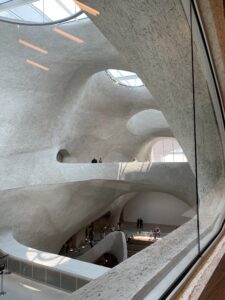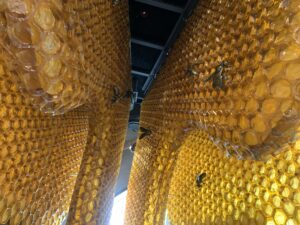
By Emily Clott, Class of 2012
Photos by the author
What self-respecting fan of Chicago’s architecture doesn’t appreciate the work of Jean Gang and her atélier, Studio Gang? Gang, who lives and works among us, has impacted our city’s skyline in a major way. But does Gang’s work hold up in other locales, cities whose self-regard is at least triple that of Chicago’s? You bet your life it does! Case in point, the new wing of the American Museum of Natural History (AMNH) in Manhattan.
On a trip to New York for a family graduation, the hubs and I checked out some architecture, as CAC volunteers do. We’d read the hosannas showered on the AMNH’s new wing by the New York Times, Architectural Digest, and Dezeen, and wondered if the building could possibly live up to the hype. In our opinion, it does indeed!
Unlike Chicago’s Field Museum of Natural History where the entire collection is housed in one very large building, New York’s AMNH consists of multiple buildings, completed over decades. The early buildings showcase the Victorian Gothic, Richardson Romanesque, and Beaux Arts styles popular at the time they were built.

The new Gang-designed Richard Gilder Center for Science, Education, and Innovation is a striking contrast to those earlier architectural designs. It is cave-like, curvy, a little like stepping into an episode of the Flintstones. It reminds me of Gaudi’s work in Barcelona. Gang intended the elements to evoke “geological strata, glacier-gouged caves, curving canyons, and blocks of glacial ice.” Architects specified the use of shotcrete, a high-velocity method of applying concrete through a hose, to create this effect.

The result is an experience completely different from any we’ve ever had in a museum, partly due to expert curation on the part of museum staff. But the architectural design leads the way. The flow of exhibits from one to the next follows a logic, yet the curves and skylights, nooks and crannies result in surprises that engage and immerse the visitor at every turn.

The Insectarium, for example, inspired a new-found awe and appreciation for those pesky bugs so essential to the web of life despite our tendency to see them as pests. Their contributions and the incredible survival mechanisms they’ve evolved are demonstrated in the amazing “super organism” functioning of a leaf-cutter ant colony and the “Pollination Portal” that shows how insects are essential to pollination, the key to our food supply. Interactivity is essential to the entire exhibit, with opportunities for guests to “Be a Bee,” for example and to see Leaf Cutter Ants as they parade through an elaborate ant highway to do their work.

A fully immersive, 360 degree video experience takes the visitor from the vast depths of the ocean to the network of microscopic nutrient transport on the surface of a leaf to the forces of air and moisture that create climate.
Rather than being shut away behind closed doors, labs and storage rooms can be seen behind windows. The visitor is encouraged to imagine how cool it would be to do this kind of work, to discover nature’s secrets oneself.
A gorgeous library encircles a central support system that resembles a giant mushroom, continuing the marriage of form and function that Studio Gang executes so well.

At a moment when it’s easy to be discouraged about the future of learning, science learning in particular, Jean Gang and company have created a space where one is compelled to want to learn more, to discover more. Adventures in science wait around every curve, inviting all to join in the feast.

AMNH is located in Manhattan at 200 Central Park West. The new wing opened to the public May 4, 2023.
CLICK HERE for more stories on The Bridge.


Light-hearted, engaging review for a fantastic new building. With excellent photographic documentation. Thanks, Emily.
Emily, really interesting article and great photos. Thanks for doing this
Great article and pictures, Emily. The outside of Gang edition reminds me of River City. Especially love the video of the leaf cutters
Emily, you convinced me. We have to visit this the next time we’re in NYC. Looks great — and I think Russ is correct. Some aspects look like Goldberg’s River City eyebrow wihdows. Thanks for the article and kudos to you and Chris for your entrepreneurial visitations.
So lucky you were to visit this new wonder AND so lucky CAC Bridge readers are to enjoy the experience through your photos and observations! Thanks. Suzy Ruder
Thanks, Emily, for giving us all this view of Jeanne’s work! Two comments:
Form follows function
Very reminiscent of Gaudi’s work.